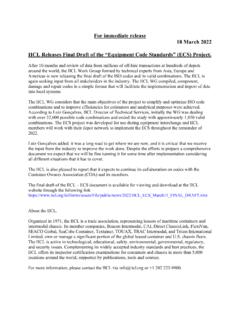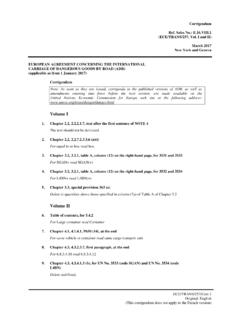Transcription of R134a REFRIGERATION TECHNICIAN HANDBOOK
1 R134a REFRIGERATION TECHNICIAN HANDBOOK Version Updated: May 10, 2012 USACO TABLE OF CONTENTS OVERVIEW .. 4 BACKGROUND .. 4 HANDBOOK INTRODUCTION .. 5 SAFETY AND ENVIRONMENTAL NOTES .. 5 RECEIVING REFRIGERATED CONTAINERS ON DANGER LIST' .. 6 HANDLING PROCEDURES FOR ALL R134a REFRIGERATED UNITS .. 7 IDENTIFYING FAKE / COUNTERFEIT R134a REFRIGERATED GAS .. 8 R134a REFRIGERATED CYLINDER TESTING UNIT AND PROCEDURES .. 9 HALIDE TORCH AND VENTILATION HOOD ASSEMBLY .. 9 CONGLOBAL GAS EXTRACITON AND ANALYSIS RECOVERY SYSTEM (C GEARS) .. 11 PROCEDURES FOR EXTRACTING AND TESTING R134a REFRIGERATED GAS CYLINDERS .. 12 LABELLING AND TRACKING TEST RESULTS .. 14 NEW SAFETY REQUIREMENTS FOR SERVICING R134a REFRIGERATED CONTAINERS .. 16 ADDITIONAL SAFEGUARDS IMPLEMENTED AT CONGLOBAL INDUSTRIES .. 17 CONGLOBAL GAS EXTRACTION AND ANALYSIS RECOVERY SYSTEM (C GEARS).
2 19 SAMPLING METHODS .. 19 IMPORTANT PRECAUTIONS .. 19 C GEARS METHOD TO CHECK REFRIGERATION MACHINERY FOR CHLORIDE CONTAMINATION .. 20 PREPARATION .. 20 EQUIPMENT .. 20 PREPARING THE C GEARS DEVICE .. 22 TAKING SAMPLES FROM REFRIGERATION MACHINE .. 23 SAMPLE PORTS .. 23 SAMPLING PROCESS .. 23 FLAME TESTING OF EXTRACTED SAMPLES .. 27 FLAME TEST RESULTS .. 28 CLEANING THE C GEARS .. 29 EMPLOYEE 30 This R134a REFRIGERATION TECHNICIAN HANDBOOK was developed as instructional guidelines for REFRIGERATION personnel of ConGlobal and its related companies. We have made this information public solely as a source of information to others who are interested in the servicing of refrigerated containers. We are making this document available as information only and are NOT PROMOTING OR SUGGESTING anyone outside of ConGlobal and its related companies adopt any of the measures contained in this document.
3 Any personnel servicing refrigerated containers should do their own investigation and implement safety policies suited to their specific situation and conditions. This HANDBOOK is intended to be an evolving document and will change as new information is discovered and made available to the industry. Comments and suggestions for improving the effectiveness of the information and procedures contained herein are welcomed and encouraged. Comments and suggestions should be directed to Priscilla Yata at ConGlobal reserves the right to amend, modify and retract any or all parts of this writing as new information may dictate. 3 | Page Version Updated: 5/10/2012 USACO OVERVIEW BACKGROUND The Refrigerated Container industry has recently experienced several instances whereby refrigerated containers have violently and unexpectedly exploded, resulting in multiple deaths of service technicians around the world.
4 To date, investigations indicate that the explosions were caused by the introduction of counterfeit R134a refrigerant containing, among other gases, significant amounts of R40 (methyl chloride). As of this writing, all of the units that have exploded received a refrigerant gas charge in Vietnam. However, an additional investigation of in stock refrigerant gas supplies at repair companies around the world, as well as on board marine vessels, has turned up counterfeit gas containing R40. Further, in a recent effort by members of the Container Owners Association (COA) who conducted a sampling and testing analysis of several hundred refrigerated units across seven locations, in three different countries, involving units from twelve different SS Lines (or Leasing Companies), revealed that some units which were not serviced in Vietnam were found and confirmed to have counterfeit / contaminated refrigerant containing several different chlorinated gasses, including R40.
5 And as expected, many of the units that received gas service in Vietnam were also found to be contaminated. This supports the growing suspicion that this counterfeit / contaminated refrigerant issue is not isolated to units having been serviced in Vietnam, as originally thought. Since the early announcements of this problem in 2011, ConGlobal Industries has been involved with an international community of experts, both in the continued investigation as well as the development of test methods to effectively screen units. ConGlobal, along with other industry leaders, has been a driving force behind the development of policies and educational programs designed to safeguard REFRIGERATION service personnel and to prevent the proliferation and spread of counterfeit / contaminated refrigerant. This issue is evolving daily, and we continue to learn more relevant information with each contaminated container identified.
6 ConGlobal Industries, Inc. and our affiliated service companies of USACO in Costa Rica, Coastal Great Southern on the East Coast, and ICAVE in Mexico, are among the largest REFRIGERATION service companies in the world. As such, we have taken a very serious view of the issue. At ConGlobal and all of our affiliated companies, the safety of our personnel as well as safeguarding our client assets are of paramount importance to us. Accordingly, we developed a series of programs, disciplines, and policies based on the most reliable and current information available. With immediate effect, all ConGlobal REFRIGERATION service facilities and service technicians are adopting the refrigerant gas handling protocol outlined in this HANDBOOK , which has been carefully designed to: 1. Safeguard our company personnel 2.
7 Safeguard our customer assets 3. Stop the proliferation of contaminated gas in our industry 4 | Page Version Updated: 5/10/2012 USACO HANDBOOK INTRODUCTION On November 11, 2011, the company issued the first SAFETY BULLETIN relative to news that isolated refrigerated units around the world had exploded, causing casualties, including fatalities. The Company (herein meant to include ConGlobal Industries, Coastal Great Southern, Container Care Icave Mexico, Container Care Mexico, and USACO Costa Rica) issued a series of policies and procedures, based on information and data known at that time, to protect the safety and well being of our employees who handle, and perform maintenance, repair, and inspection of refrigerated containers. A great deal of information and knowledge has been accumulated since that date.
8 This REFRIGERATION TECHNICIAN HANDBOOK is to be used as the exclusive set of policies and procedures for handling refrigerated container units within and by all company personnel and supersedes any prior communication. Each and every REFRIGERATION TECHNICIAN in the company must be trained in the procedures outlined in this manual by their supervisor. In addition, every REFRIGERATION service TECHNICIAN will sign the acknowledgment page at the end of this manual, confirming they have read the manual in its entirety; they have been trained by their supervisor; and they fully understand and agree to abide by all the policies and procedures found within this manual. In addition, the General Manager will sign the acknowledgement page, verifying the employee has been trained and is satisfied the employee has the required information and skill to safely work on all REFRIGERATION units.
9 There will no deviation from these policies and procedures without the explicit written approval of either the President or Director of Safety and Compliance of the company. The policies and procedures found within this manual apply to ALL R134a REFRIGERATION UNITS serviced by our company. Any REFRIGERATION TECHNICIAN who does not feel completely comfortable complying with the policies and procedures found in this manual must express their concerns with their supervisor prior to commencing work on any refrigerated unit. Any REFRIGERATION TECHNICIAN who observes anything out of the ordinary on any REFRIGERATION unit must immediately stop and report their concerns to their immediate supervisor. SAFETY AND ENVIRONMENTAL NOTES A byproduct of burning hydrocarbon chloride is phosgene gas, which is a lethal gas in certain concentrations.
10 To ensure that the Halide Flame test can be safely performed using the ventilation hood described in this HANDBOOK ; ConGlobal contracted an environmental hygienist from AECOM to test the environment at various distances around the vent hood, including a sampling device located on the testing TECHNICIAN , and at the exhaust outlet. AECOM used OSHA Method 61 as a basis for completing the sample. The sample period lasted five hours and 6 burn tests were performed, 5 of which lasted approximately 30 seconds, and the final burn lasting approximately 1 minute. Both R22 and R134a refrigerant were tested. Since R22 contains chloride, it produces phosgene gas when burned allowing AECOM to test the air quality and record the results. 5 | Page Version Updated: 5/10/2012 USACO The AECOM TECHNICIAN tested air flow rates, construction of the hood assembly, and smoke test observations.










